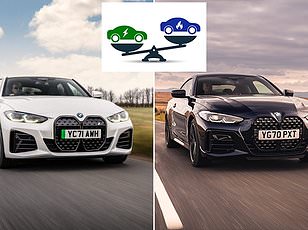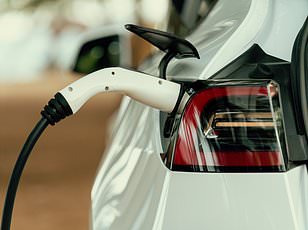EXCLUSIVEHow government EV sales targets are forcing car makers to use drastic tactics to inflate numbers
- MG's commercial director says the industry's witnessing behaviour and tactics 'not seen in 40 years'
- Makers are slashing EV prices, utilising Motability and adding more dealer demonstrators to boost numbers
- We take a deep dive into which brands are struggling to meet ZEV mandate requirements and why
Car makers are having to resort to tactics 'not seen in the industry for 40 years' in a ploy to increase EV sales in order to meet binding targets to set out by the Government, an industry insider has exclusively told This is Money.
The Zero Emission Vehicle (ZEV) Mandate was introduced in January in what ministers called 'the world's most ambitious regulatory framework for the transition to electric vehicles'.
Requiring manufacturers to sell more EVs in the build up to the 2035 ban on new petrol and diesel models, it's become the big stick to beat mainstream motor brands into accelerating their green ambitions. Those who don't meet targets can face a fine of £15,000 each on petrol or diesel cars sold.
But already halfway through the year, and with many manufacturers saying they're 'not anywhere near the targets', automotive brands are having to resort to increasingly drastic methods of market manipulation to inflate their EV numbers.

The ZEV Mandate effect: Guy Pigounakis, commercial director of MG UK, says the 'horrific fines' for not hitting Government EV sales targets are responsible for 'behaviour from manufacturers not seen in 40 years'
Guy Pigounakis, commercial director of MG UK, told This is Money that the industry is already witnessing an array of strategies to meet the ZEV mandate thresholds for 2024.
For instance, Ford has said it could restrict the number of new petrol models available to UK customers to artificially inflate its EV sales share.
French manufacturer Renault is even offering a kooky 'Relationship Breakdown Cover' to buyers of its electric Scenic model – refunding couples who divorce or dissolve a civil partnership after taking delivery of the EV.
Such moves are a reaction to the huge fines if brands fail to meet ZEV mandate targets, and come as the Society of Motor Manufacturers and Traders' (SMMT) latest data shows electric car sales 'remain behind mandated transition trajectory' as private registrations continue to stagnate.
What is the ZEV Mandate?

Electric future: The ZEV mandate will force car makers to sell an increasing volume of EVs between now and 2035
The ZEV mandate came into force on 3 January 2024. By law, a pre-determined percentage of manufacturers' car sales need to be EVs, starting with 22 per cent this year and increasing thereafter.
The target scales up to 28 per cent in 2025, 80 per cent by 2030 and to 100 per cent in 2035, when the ban on sales of new petrol and diesel motors comes into force (although this may change under the new Labour Government).
Failure to meet the ZEV mandate thresholds can result in 'horrendously expensive' fines for mainstream manufacturers of £15,000 per car below the required threshold.
On the face of things, the mandate is an order to car makers to do more to make EVs appealing to Britons. But critics say it is a back-handed way of ministers pushing electric vehicles onto drivers at a time when many are not ready or willing to make the transition away from petrol and diesel.
How far behind ZEV targets are manufacturers?
A glance at the top-line sales figures will suggest that EV registrations are up year-on-year.
However, closer inspection shows the electric car market share is just 16.8 per cent of all registrations - so, well off the 22 per cent required by the mandate.
As reported by This is Money, it is fleets that are propping up the electric car market, with private sales going into reverse in recent months as drivers back away from the concept of shifting to battery power. Although fleet sales include those through work salary sacrifice schemes, where employees can buy electric cars and make a big tax saving.
Guy Pigounakis says: 'If you look at the absolute number of electric cars being registered it's a superficially positive story.
'What we're [the market as a whole] seeing is a significant reduction in the private sector - private buyers who don't have any benefit from company cars or Motability.
'That market is 11.1 per cent down which is very, very significant.
'The corporate market – where there are Benefit in Kind advantages for company car drivers - is compensating. There are tax write downs for the company supplying those cars as well.
'And electric cars are proven to be very, very successful as salary sacrifice vehicles for corporate buyers.'
For many manufacturers, private customer buying needs to increase fast if they've got any hope of complying with the mandate.

Ford's electric car division boss has said that the brand's plans to go all-electric in Europe from 2030 was 'too ambitious' as he confirmed that the company will continue to offer hybrids

Fiat CEO Olivier Francois said the car firm would reintroduce a petrol version of its 500 city car due to a lack of demand for electric vehicles, particularly among older drivers

Renault CEO, Luca De Meo (pictured), has said that the 2035 deadline for reaching 100% electric new cars is unrealistic and called for 'more flexibility' in the schedule to shift to EVs
Huge brands including Renault, Volkswagen, Land Rover, Ford and Toyota are falling behind the required 22 per cent set by the Government for 2024 zero emission sales, Autocar reported last month.
Manufacturers that fail to comply with the targets face fines of £15,000 for every non-ZEV car and £18,000 per non-ZEV van.
There are allowances for the brands that are dragging behind, though.
Any excess non-ZEV sales can be covered by purchasing allowances from other manufacturers, using allowances from past or future trading periods during the initial years of the policy, or offsetting with credits.
Extra credits are offered for vehicles deployed with car clubs, or those that are wheelchair accessible.
All-electric manufacturers like Tesla, Polestar, Smart, GWM Ora and BYD - whose model ranges only offer zero-emission cars – have nothing to worry about and face the lucrative prospect of becoming a main source of ZEV credits for other brands.
The select few car makers still selling a mix of fuel types that are on course to meet the targets this year include MG, Cupra, Subaru, BMW, Volvo and Jeep, all of them successfully increasing their EV availability.
For other major brands that are falling short of the 22 per cent threshold, it's a case of either buy credits, defer allowances to next year or pay, as Guy calls them, the 'truly horrific fines'.
The tricks and tactics manufacturers are using to artificially inflate EV sales
1. Slashing prices
The easiest of all tactics is to make EVs more affordable. Lexus is doing just that.
The Japanese luxury car brand confirmed last month it has cut new EV prices by over £7,000. The UX300e saw prices drop by £6,700, with higher specs falling by as much as £7,100. The larger RZ450e came down by £2,100 too for the standard version in an effort to boost sales.
This is despite Lexus' EV share sitting at around 30 per cent, which is well ahead of the mandate's requirement for 2024.
Vauxhall this week added a new base-spec version of its electric hatchback, the Astra Griffin Electric, with a price of £34,995, as it tries to tempt customers to consider battery power.
Also looking to invigorate interest in its electric cars by making them less expensive is Fiat.
In June, it confirmed it will not only extend its £3,000 'E-Grant' for all EVs, it has knocked a further £3,200 from the list prices of its 500e and 500e Convertible.
2. Motability
The Motability Scheme is a programme that allows disabled people to lease a new car, wheelchair-accessible vehicle, scooter, or powered wheelchair.
Utilising this tactic to increase EV sales flies under the radar but is very effective.
'In terms of where the opportunities lie and where people are exploiting the market, Motability is a huge, huge market. And it's growing massively', Guy explains.
Sales have increased 83 per cent year on year.
Despite spending over 40 years in the automotive industry, this year will be the strongest Motability market Guy can remember: 'It's almost defying everybody's forecast,' he says.
Motability responds well to aggressive positioning because customers typically want the best financial deal they can get, Guy says: 'Every manufacturer is aggressively positioning their cars with very low advance payments to try and get people to choose an EV over petrol or diesel.
'You're seeing manufacturers offering huge discounts'.
And the market is new to electric car usage, which offers a 'relatively new, untouched electric market', which Guy says will account for a 'very significant 18 to 20 per cent of the total opportunity'.
3. Dealership demonstrators
Demonstrator cars are used by dealerships for test drives and as display models in the showroom.
Under the pressure of the ZEV mandate and dealer specific electric car sales targets, these demo models are being used as another method to artificially notch-up EV registrations.
There's a real concerted push by manufacturers and dealers to sell more electric cars, so they put more demonstrators on. According to Guy, this translates to a 'significant 44 per cent year-on-year growth of demonstrators [across the network of all brands],' all of which count towards registrations.
He explains that a key factor to this is the criteria mix between internal combustion engine (ICE) cars and electric cars that dealers have likely had put on them by their supplying manufacturer - often dealers are told they need to achieve a certain volume of EV sales to unlock bonuses, leading dealers to put on vehicles as demonstrators.
'There's a lot of pressure on dealers from some manufacturers to sell a specific mix of cars, and of course that mix of cars is designed to get the total sales of that manufacturer as close to, or in excess of, 22 per cent as they possible can in line with the ZEV mandate'.
The long-term repercussions of market manipulations
While manufacturers are left with little choice but to pull all the short-term tricks out the hat to hit the ZEV targets, over the long term these can have significant consequences.
While discounts can generate a 'genuinely measurable incremental sales increase', Guy warns that they 'also have a damaging impact on residual values'.
Damage to a car's residual value – how much a car is worth after a certain time period and mileage – has to be weighed up against the financial exposure of paying fines in the case of the ZEV mandate.
'It's a commercial calculation they [car brands] will be taking,' he said.
Residual value is also the issue for dealers upping their EV mix with demonstrators. Dealers are left with a forecourt of used, low mileage (just test mileage) EVs, and because of the current climate – May analysis from J.D. Power reported many used car markets across Europe seeing EV residual values fall month on month and year on year – means these cars can take on 'some quite big negative adjustments'.
Because the situation can be 'very, very expensive to pursue', Guy has seen a bit of 'kick back' from dealers.
Matt Galvin, UK managing director at Polestar told us: 'Whilst we are seeing some price parity between used petrol/diesel and EVs starting to appear, the used car market plays a critical role in underwriting the residual value and sale of new EVs.'
PETROL - Residual Value
Cap HPI data

Model: BMW 4 Series Coupe
Trim: M440i xDrive MHT 2dr Step Auto
Year: 2021
Power: 374bhp
Price new: £59,585
Value after 1yr, 10k miles: £43,400 (-27.2% yoy)
Value after 2yrs, 20k miles: £38,100 (-12.2% yoy)
Value after 3yrs, 30k miles: £33,600 (-11.8% yoy)
ELECTRIC - Residual Value
Cap HPI data

Model: BMW i4
Trim: 250kW eDrive40 M Sport 83.9kWh 5dr Auto
Year: 2021
Power: 340bhp / Range: 357 miles
Price new: £60,215
Value after 1yr, 10k miles: £37,800 (-37.2%)
Value after 2yrs, 20k miles: £34,200 (-9.5%)
Value after 3yrs, 30k miles: £30,925 (-9.6%)
EV prices will need to come down
Affordability is the main issue surrounding EV uptake, and MG is well placed to know this as its £26,995 MG4 was - until recently - one of the cheapest (and best-selling) battery cars available in the UK.
To inject private buying back into the EV market and rejuvenate retail sales, the cars need to be less expensive to buy new, Guy says.
'We need to bring EVs to market which have price parity with ICE cars – and I firmly believe once they achieve price parity with petrol competitors there will be a far higher degree of take up from customers.'

Shown is the new Polestar 3. Polestar's Matt Galvin says: 'This mandate can work only if combined with stimulating private customer demand which could include; a temporary relief on VAT on new electric vehicles, bringing public charging VAT in line with 5 per cent VAT for charging at home, extending congestion charging exemptions, and adjusting threshold on the VED expensive car supplement to reflect today’s heightened prices, not those of 2017 as currently proposed'
And cheaper electric cars are coming.
Dacia has opened order books for its new Spring EV starting from just £14,995 and the new Citroen e-C3 costing as little as £21,035. A number of £23,000 models are also in the pipeline from Hyundai, Renault and VW and market analysts say falling battery prices should see EV production costs drop to a similar level as petrol cars by around 2026.
Polestar agrees that price parity is crucial to adoption but is also calling for the government to stimulate private customer demand, with Matt Galvin commenting: 'Policymakers to date have focussed solely on punitive measures rather than offering much needed incentives; all sticks, no carrots.
'The transition from ICE to EV is also dependent in part on lowering the entry point to access this technology.'
Mike Hawes, SMMT chief executive, also spoke out on the mandate and making it fair for manufacturers.
'With the UK having arguably the toughest regulation in the world, with a mandate that compels the sale of these vehicles, we also need to ensure there are measures to compel demand,' Hawes told us.
And what about 2035 (or 2030 if it's brought forward by Labour?)
The industry tends to be split into three camps: manufacturers that are comfortably ahead of the ZEV targets and don't see why they should be relaxed when they've invested so much to achieve them; the brands falling desperately behind the 22 per cent threshold; and finally those that are nowhere on the scale of electrification demanded.
'The views will be polarised between them,' Guy acknowledges as commercial director of a manufacturer who sits in Camp A.
He believes that if the industry was told '2030 is a drop-dead date [ZEV targets abolished for a blanket ban on new ICE cars and vans], there'd be a huge sigh of relief from most manufacturers.'
He went on: 'I personally don't believe that it would slow down the transition of manufacturers into building EVs because you don't decide to build EVs overnight.
'The problem with the ZEV mandate is the speed at which those volumes come in have left the industry gasping [...] but it's a big step for the government to say, "we trust the industry to make that transition" and leave alone.'
If the 2030 ban is reintroduced, wholesale changes - or entire scrapping - of the ZEV mandate would be required because the annual targets will no longer be on the same course of trajectory.
Polestar's Galvin said what the sector needs right now is 'certainty' about the direction minsters want to take.
'With the recent change in government, there's now a proposal to reverse the decision to delay the transition to pure electric vehicles from 2030 to 2035; a U-turn on the U-turn.
'What vehicle manufacturers need is certainty to support product lifecycle planning.'




















